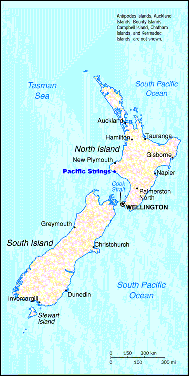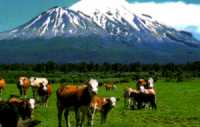|
|
 |
|
The basic story of natural gut
What is natural gut racquet string made of?Although natural gut string manufacturers prefer to think otherwise, the raw material is a by-product of the meat industry and comes from a variety of animals including the intestines of sheep, cattle, kangaroo, and water buffalo. (We use only beef serosa.) Where are PACIFIC natural gut strings made?Our PACIFIC natural gut string comes from clean, green New Zealand, the country with the cleanest air and some of the richest soil in the world. The PACIFIC Natural Gut String Company is located on the Surf Highway in Manaia on the West Coast of New Zealand’s North Island. It lies in the shadow of Mount Taranaki, an active volcano which last erupted in 1755, is bordered on two sides by the Kaupokonui river, and is about one kilometer from the Tasman Sea. All in all, not a bad place to spend some time (as long as the mountain stays asleep.)A quick geography lesson for those who are interested. New Zealand is located in the South Pacific, about 3000 km (1860 miles) south west of Sidney Australia, 6000 km (3720 miles) from Antarctica and a 12 hour flight from Los Angeles. Look here for more info about NZ. The weather is mild with temperatures which rarely get over 25oC in the summer and most winter days are 10 -15oC. They have far more cattle than people, and beef and dairy industries are the lifeblood of the country. Combined they account for the largest portion of New Zealand’s export based economy. The cattle are range fed on some of the world’s best grasslands and are free of the bovine diseases like BSE that are common virtually everywhere else in the world. They do not need prophylactic antibiotics and growth enhancing steroids that weaken the intestinal tract. Our proximity to this plentiful supply of premium quality raw material is a great start toward a top quality product. Our Factory
The factory is located in an old cheese factory with foot thick concrete walls, and lots of space. The Tasman Sea is in the background of the photo. This factory was to become a founding partner in “Kiwi", the largest dairy factory located on one site in the world. Why is Natural Gut so good for string?Nature provided this extraordinary muscle and collagen sheath to strengthen the intestine. It’s ability to expand dramatically to accommodate a big meal and then shrink back after the food is digested and passed on is what makes natural gut ideal for racquet string. Because it was forced to do such a complex job, the beef intestine evolved into a very sophisticated structure. Comprised mainly of collagen fibers oriented in different directions this membrane has tremendous strength and elasticity. Designed to last for the animal’s entire life, this structure has to be very durable, and must have a great “performance life” just like a top-level racquet string. Where does the word Catgut come from?As far as I can tell, the only cat with intestines long enough to make a tennis string was the Saber Tooth Tiger. Since they died off long before the tennis racquet was born, we are quite sure catgut never came from cats. There are lots of other explanations that are interesting. Here are a few that I think tell the story, and you may enjoy. Historical references to the use of twisted intestinal materials for suture go back to the 2nd century AD and it’s use in musical instruments far longer. The name Catgut and it’s use as suture first appeared in the writings of Claudius Galenus around 50 AD. The word appears to have come into common use several hundred years ago because of the use of lamb gut strings in a small fiddle like instrument called a “Kit,” hence “Kitgut.” Since a small cat is also called a Kit, some say this was the evolutionary pathway from “Katgut” to “Catgut". Another maintains that the best lamb gut musical strings came from Catagniny, Germany. Top musicians demanded Catagniny Gut, which eventually evolved into “Catgut". No matter how the name came to be, it does nothing to give away our “TOP SECRET” raw material source, but we will be happy to (sort of). 
Which raw material is best for racquet strings?The first major natural gut strings were made from the innermost layer of sheep and lamb intestine called the mucosa. The collagen fibers are laid randomly, which make a very elastic membrane, but gives up some tensile strength. The texture of this tubular structure varies from smooth on one side of the circumference to rough on the other. In order to make consistent strings we cut the intestine into ribbons along its length in a process called “slitting.” Top quality strings come from the smooth side, lower quality product from the rough. Today’s larger, stiffer frames play superbly with lamb gut, but unfortunately it has serious durability problems caused by it’s relatively low tensile strength. Should we decide to manufacture from sheep threads, we would face tough competition from the food industry. The small diameter of sheep and lamb intestine makes the breakfast sausage industry its primary customer. Now that we have publicly admitted the job is impossible — I think it would be fun to try making some. Modern racquets need a higher tensile strength string, and long lengths. Because bovine, or beef, intestine meet both of these basic criteria, and there are cattle grazing right beside our factory, we thought beef might be worth a try. The differences are so great from species to species that we have to utilize different portions of the intestine. When making string from beef intestine we use the outermost layer called the serosa, this is actually a sandwich of a highly oriented collagen layer and a very random one. The highly oriented layer contributes tensile strength, the random one elasticity. Inherently a higher strength product, bovine serosa has proven to be much better suited to modern tennis string production than Sheep or Lamb. For reasons I don't fully understand, each animal species and to some extent each breed within them have different intestinal compositions. For this reason we have rigid standards defining what breed sex and age, and even what part of New Zealand our raw materials come from. How much serosa is needed for one string?In its simplest construction, a tennis string uses from seven to sixteen plies or ribbons of bovine serosa. The average animal provides between three and five. So it takes about three animals to produce one string. How is it made?The basic process is a very simple one, with lots of secrets hidden in the details. The raw serosa is mainly made up of a protein called collagen plus soluble proteins, fats, caritinoids, and other miscellaneous stuff including the occasional stone or bottle cap. The goal is to gently remove the unwanted impurities but to leave the collagen — without harming it. This is done in a water-based process involving caustic soda, soda ash, enzymes, and detergents. Depending on the process, this wet portion can take up to ten days. After cleansing, the threads are inspected and selected for quality. In some cases, they are also dyed in fashion colors. The strands are assembled into bundles containing from 2 to about 25 plies, depending on the end use. The plies are twisted together and then dried under tension on frames in very special, computer controlled, drying rooms for several days. After drying, the string has a spiral appearance somewhat like rope. A polishing step is employed to turn this into a smooth round string. Finally, in order to improve abrasion and water resistance, a special polyurethane coating is normally applied to the string. Many professional players are willing to forego the protection of a PU coating for the extra performance of an uncoated string, in this case the string is finished with a light coating of coconut oil. Deep down inside, what makes natural gut so special?It starts with the collagen molecule, a miracle which science has not been able to reproduce. Like the pictures of DNA’s double helix that we have all seen on the cover of TIME and NEWSWEEK, the molecule is quite long and in the form of a spiral or helix. The actual collagen molecule is a “triple helix” or three strands nested together to look a bit like an extremely fine rope. This triple helix is directly responsible for natural gut’s elasticity and ability to act like a shock absorber. Huge numbers of molecules combine together to form collagen fibrils. The way they are “laid up” plus the secondary chemical bonding which occurs form a very strong elastic building block. Researchers at MIT tell us that in theory it has a higher tensile strength than steel. Natural glues bond the microscopic fibrils together into collagen fibers. These are the little hairs you see coming loose from the string as it wears. These fibers are the what makes serosa special. As a sidelight, the collagen fibers in natural gut are very similar to human hair. Color? Range feed cattle live on grass, and grass is rich in caritinoids. In spite of the fact that grass is green, caritinoids are the chemicals that make carrots orange. Carotenoids are very soluble in the fats and tissues of the intestine which is one reason why they help ward off certain cancers of the bowel. They also help make raw serosa a dirty brownish orange color. In their final form some natural gut strings are a beautiful “water white” color. This is the result of what the animal was fed and/or chemical bleaching. While some of these products are excellent, we believe that bleaching weakens the collagen, and do not do it. Our strings are decolorized by an extraction process that simply washes out most of the pigmentation, with a minimum of fiber damage. Here is a story that illustrates our point. One of our consultants is the retired director of research from a major hair care company. While we were having lunch he pointed out a young lady with lovely long blond hair, and asked how I could tell if the color was natural. With the means at my disposal, I simply didn’t know. His answer was simple, “by the length, heavily bleached hair does not have enough strength to support it.” As a result of our bleaching philosophy our PACIFIC natural gut products can vary in color from a light gold to honey. What else is it used for?Historically, the surgical suture industry was the major customer for serosa. World War II required so much suture that string production was halted. In recent years a totally new market has developed, the Japanese have been buying the intestine for use as a gourmet food — they place it on a stick and barbecue it like a kabob. Two other significant markets are strings for musical instruments and grandfather clocks. Because of the potential for rejection by the body, natural gut suture use is on the decline and is rapidly being replaced by synthetic materials. Now that we have talked all the way around the subject, I guess it’s time to get to the point — natural gut racquet strings. |
|
HOME | OUR GUT | OUR NYLON | OUR POLY | TIPS | RAVES | LINKS | SEARCH |